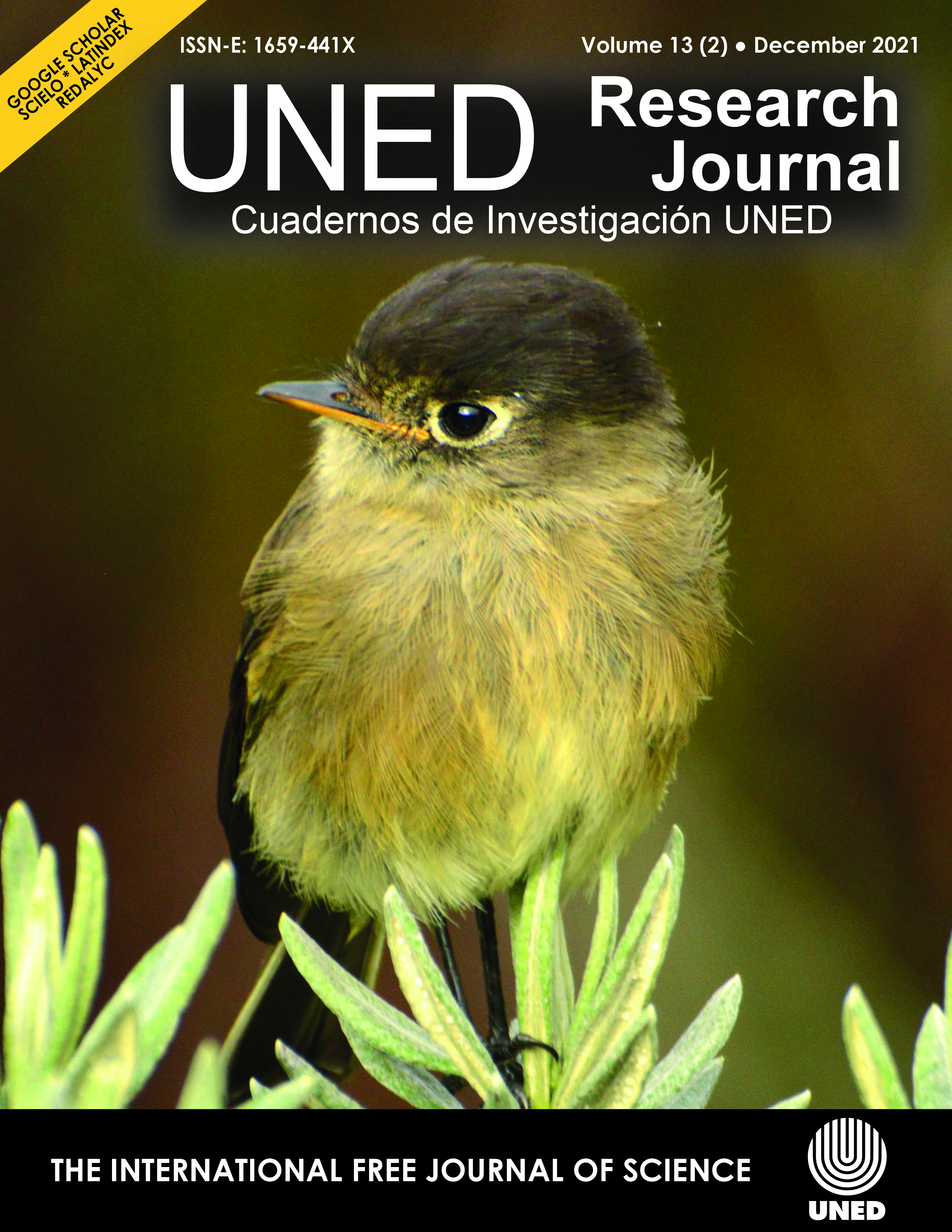Invasive potential of the Eurasian cricket Acheta domesticus (Orthoptera: Gryllidae) in Costa Rica
DOI:
https://doi.org/10.22458/urj.v13i2.3529Keywords:
Arthropods, culture, hatcheries, protocol, scientific technical studyAbstract
Introduction: The high nutritional value of insects has led to the consideration of their massive production to complement the production of animal protein. In Costa Rica, the importation of the Eurasian “house cricket”, Acheta domesticus, for protein production, is not legal for lack of a study of its invasive potential. Objective: To analyze the invasive potential of A. domesticus and to propose a protocol for the required study. Methods: We analyzed the ecological requirements of A. domesticus in the ecological categories called “Holdridge life zones” using the Costa Rican cricket Anurogryllus muticus as a model. Results: Only three Costa Rican life zones can be considered viable for A. domesticus. Conclusions: A. domesticus is unlikely to survive in the field in Costa Rica. Here we present a detailed protocol for a formal study leading to legal importation of the species.
References
Arias, J., Bonilla, F., & Sasa, M. (2016). Desarrollo de la herpetocultura en Costa Rica: Situación actual de herpetarios y manejo ex situ de reptiles y anfibios. Revista de Ciencias Ambientales, 50(1), 1-23. https://doi.org/10.15359/rca.50-1.1
Bowles, D. E. (2018). Introduced Japanese burrowing cricket (Orthoptera: Gryllidae: Velarifictorus (Velarifictorus) micado) range continues to expand in North America. Journal of Orthoptera Research, 27(2), 177-181. https://doi.org/10.3897/jor.27.29067
DeFoliart, G. R. (1997). An overview of the role of edible insects in preserving biodiversity. Ecology of Food and Nutrition, 36(2-4), 109-132. https://doi.org/10.1080/03670244.1997.9991510
Fiaboe, K. K. M., Peterson, A. T., Kairo, M. T. K., & Roda, A. L. (2012). Predicting the potential worldwide distribution of the red palm weevil Rhynchophorus ferrugineus (Olivier) (Coleoptera: Curculionidae) using ecological niche modeling. Florida Entomologist, 659-673. https://doi.org/10.1653/024.095.0317
Haldar, P., Das, A., & Gupta, R. K. (1999). A laboratory based study on farming of an Indian grasshopper Oxya fuscovittata (Marschall) (Orthoptera: Acrididae). Journal of Orthoptera Research, 93-97. https://doi.org/10.2307/3503431
Hanson, P. (2016). Los insectos invasores de costa rica. Biocenosis, 22(1-2). Recuperado a partir de https://revistas.uned.ac.cr/index.php/biocenosis/article/view/1255
Janzen, D. H., & Chavarría, M. T. (1991). Historia Natural de Costa Rica (No. B50/1057). San José (Costa Rica). Capitulo VII. Plantas de Costa Rica. pp.119-353.
Lee, H. J., & Loher, W. (1995). Changes in the behavior of the female short-tailed cricket, Anurogryllus muticus (De Geer) (Orthoptera: Gryllidae) following mating. Journal of insect behavior, 8(4), 547-562. https://doi.org/10.1007/bf01995326
Nakagaki, B. J., & Defoliart, G. R. (1991). Comparison of diets for mass-rearing Acheta domesticus (Orthoptera: Gryllidae) as a novelty food, and comparison of food conversion efficiency with values reported for livestock. Journal of Economic Entomology, 84(3), 891-896. https://doi.org/10.1093/jee/84.3.891
Otte, D. (2006). Eighty-four new cricket species (Orthoptera: Grylloidea) from La Selva, Costa Rica. Transactions of the American Entomological Society, 299-418. https://doi.org/10.3157/0002-8320(2006)132[299:ENCSOG]2.0.CO;2
Parajulee, M. N., Defoliart, G. R., & Hogg, D. B. (1993). Model for use in mass-production of Acheta domesticus (Orthoptera: Gryllidae) as food. Journal of economic entomology, 86(5), 1424-1428. http://doi.org/10.1093/jee/86.5.1424
Pino-Moreno, J. M., Aguilar-Piedra, H., & Paniagua-Rodríguez, F. (2014). Analisis preliminar de los insectos comestibles de Costa Rica: status actual y perspectivas. Entomología Mexicana, 1: 1028– 1033.
Quirós-Blanco, A. M., Fallas, P., & Acosta, Ó. (2019). Retos y oportunidades de los insectos comestibles como fuente de proteína sostenible en Costa Rica. https://cita.ucr.ac.cr
Roe, R. M., Clifford, C. A., & Woodring, J. P. (1985). The effect of temperature on energy distribution during the last-larval stadium of the female house cricket, Acheta domesticus. Journal of insect physiology, 31(5), 371-378. http://doi.org/10.1016/0022-1910(85)90080-0
Rumpold, B. A., & Schlüter, O. K. (2013). Potential and challenges of insects as an innovative source for food and feed production. Innovative Food Science & Emerging Technologies, 17, 1-11. http://doi.org/10.1016/j.ifset.2012.11.005
Santurino, C., García-Serrano, A., Molina García, J., Sierra Fernández, P., & Castro-Gómez, M. P. (2016). Los insectos como complemento nutricional de la dieta: fuente de lípidos potencialmente bioactivos. ANS. Alimentación, nutrición y salud, 23(2), 50-56. http://hdl.handle.net/10261/150384
Sasa, M., Chavez, G. & Porras, L. W. (2010). The Costa Rican herpetofauna: Conservation status and future perspectives. En Wilson, Larry David, Josiah H. Townsend, & Jerry D. Johnson. Conservation of Mesoamerican Amphibians and Reptiles (pp. 509–603). Eagle Mountain, Utah, United States: Eagle Mountain Publications, LC.
Van Huis, A., Van Itterbeeck, J., Klunder, H., Mertens, E., Halloran, A., Muir, G., & Vantomme, P. (2013). Edible insects: future prospects for food and feed security (No. 171). Food and Agriculture Organization of the United Nations.
von Hackewitz, L. (2018). The house cricket Acheta domesticus, a potential source of protein for human consumption. Swedish University of Agricultural Science, Department of Molecular Sciences. 2018:17. Online Publication: https://stud.epsilon.slu.se
Walker, T. J., & Whitesell, J. J. (1982). Singing schedules and sites for a tropical burrowing cricket (Anurogryllus muticus). Biotropica, 220-227. http://doi.org/10.2307/2388028
Published
How to Cite
Issue
Section
License
Copyright (c) 2021 UNED Research Journal

This work is licensed under a Creative Commons Attribution 4.0 International License.
Note: This abstract contains an incorrect copyright due to technical issues. Authors who publish with this journal agree to the following terms: Authors retain copyright and grant the journal right of first publication with the work simultaneously licensed under a Creative Commons Attribution License that allows others to share the work with an acknowledgement of the work's authorship and initial publication in this journal
All journal contents are freely available through a CC BY 4.0 license.
CC BY 4.0 is a Creative Commons: you can copy, modify, distribute, and perform, even for commercial reasons, without asking permission, if you give appropriate credit.
Contents can be reproduced if the source and copyright are acknowledged according to the Open Access license CC BY 4.0. Self-storage in preprint servers and repositories is allowed for all versions. We encourage authors to publish raw data and data logs in public repositories and to include the links with all drafts so that reviewers and readers can consult them at any time.
The journal is financed by public funds via Universidad Estatal a Distancia and editorial independence and ethical compliance are guaranteed by the Board of Editors, UNED. We do not publish paid ads or receive funds from companies.
